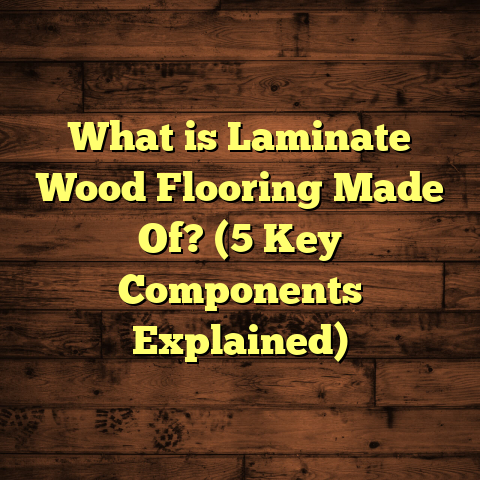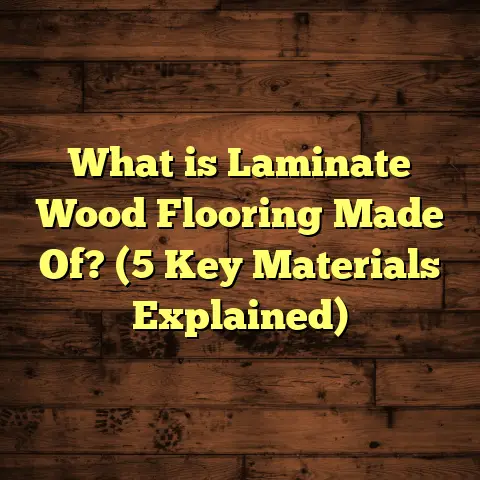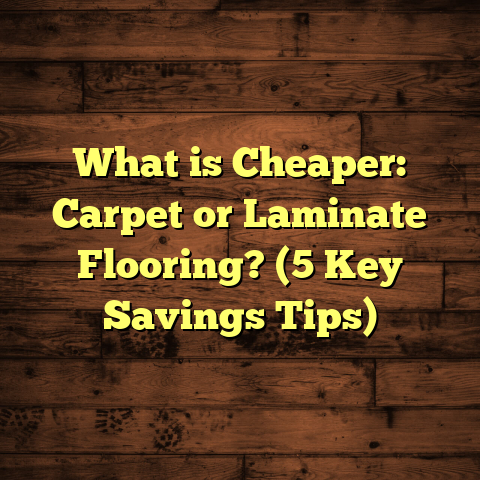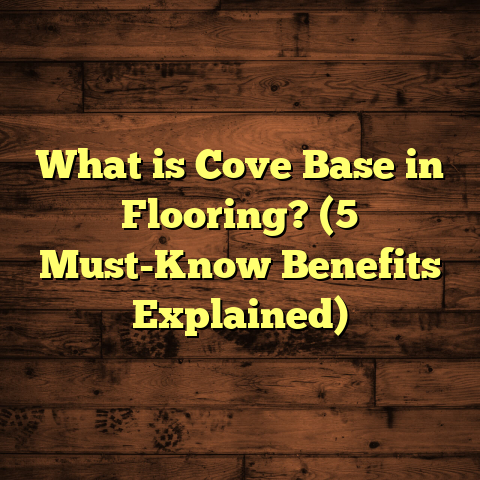What is Veneered Engineered Wooden Flooring? (5 Key Benefits Revealed)
Comfort is something I always keep in mind when choosing flooring for a home. There’s nothing quite like the feeling of walking barefoot on a warm, sturdy floor that feels good underfoot and looks beautiful at the same time. Over the years, I’ve installed countless floors, and one type that truly stands out for balancing these qualities is veneered engineered wooden flooring. It’s a flooring solution I turn to again and again because of its versatility, durability, and aesthetic appeal. I want to share what I know about it—what it really is, the key benefits I’ve observed, some technical details, and how it stacks up cost-wise.
What is Veneered Engineered Wooden Flooring?
Let’s start right here: what exactly is veneered engineered wooden flooring? I often get this question from homeowners who hear the term but aren’t sure how it differs from other wood floors.
Veneered engineered wooden flooring is essentially a layered wood product designed to give you the best of both worlds—the beauty and feel of real hardwood on top combined with a stable core underneath. The “veneer” refers to the thin layer of natural hardwood that forms the surface of the floor. This veneer can range from about 0.6mm to as thick as 6mm depending on the product and manufacturer. Beneath this veneer lies multiple layers of plywood or high-density fiberboard (HDF) arranged in a cross-grain pattern. This cross-grain structure enhances the floor’s stability by reducing movement caused by humidity and temperature changes.
In contrast, solid hardwood flooring is just one solid piece of wood all the way through. That makes solid wood more prone to expanding, contracting, or warping in areas with fluctuating moisture levels.
I remember explaining this to a client last year who was worried about installing solid wood in her coastal home with salty air and moisture swings. We decided on engineered wood with a thicker oak veneer, which gave her peace of mind knowing her floors would remain beautiful year-round.
The Anatomy in Detail
To help visualize it better: think of veneered engineered flooring as a multi-layered sandwich.
- Top Layer (Veneer): Real hardwood species such as oak, maple, cherry, walnut, or exotic woods like Brazilian cherry. This layer provides the authentic wood grain and can be sanded and refinished.
- Core Layers: These are typically plywood strips or HDF sheets stacked crosswise (perpendicular to each other). This cross-layering minimizes dimensional changes.
- Bottom Layer (Backing): A thin plywood or fiberboard layer balances the floor and keeps it flat.
This construction makes veneered engineered floors less sensitive to moisture than solid wood, allowing them to be installed in places like basements or over radiant heating systems where solid wood might fail.
Why I Recommend Veneered Engineered Wooden Flooring: Five Key Benefits
I’d like to share five major advantages I’ve seen firsthand that make veneered engineered wooden flooring a smart choice for many homeowners.
1. Stability and Durability That Really Impresses
Stability is where engineered wood floors shine. Because of their multi-layered core with alternating grain directions, they resist expansion and contraction better than solid hardwood.
I had one project in a home located in an area with high humidity swings—from summer highs around 80% relative humidity to dry winters near 30%. Solid hardwood floors there would have cracked or warped within a year. Instead, we installed engineered wood with a 4mm oak veneer, and two years later the floor looks as pristine as ever.
According to industry data, engineered wood floors can tolerate moisture content variation up to 12% better than solid hardwood floors. This translates into fewer maintenance headaches for homeowners.
This stability also means fewer gaps between boards during seasonal changes. For families with pets or kids who run around the house, this is a huge plus because you avoid dust accumulation in cracks or uneven surfaces.
2. Authentic Wood Appearance with Greater Design Flexibility
When people ask me if veneered floors look “real” enough compared to solid wood, I always say yes—the difference is barely noticeable once installed.
Because the top veneer is genuine hardwood, you get all the natural grains, color variations, textures, and warmth inherent to wood. Whether it’s knotty pine or smooth maple, the floor brings natural beauty into your space.
What’s more interesting is that engineered wood allows manufacturers to use exotic species more economically since only a thin slice is needed for the veneer. For example, Brazilian cherry or tigerwood veneers are more accessible at costs far below solid hardwood planks made entirely from those woods.
I recall a client who wanted an elegant dark walnut floor but couldn’t afford solid walnut. An engineered option with a walnut veneer gave her the exact look she wanted at nearly half the price.
Plus, finishes on engineered floors vary widely—matte, satin, gloss—and you can find pre-finished options that speed up installation without sacrificing quality.
3. Easier Installation Options Save Time and Money
One big plus I appreciate—and my clients do too—is how flexible engineered wood flooring is when it comes to installation.
Thanks to its structure, veneered engineered flooring can be installed several ways:
- Floating Floor: Boards click together over an underlayment without adhesive or nails.
- Glue-down: Adhesive secures boards directly to subfloor.
- Nail-down: Where nails or staples fix boards to wooden subfloor.
This flexibility means I can tailor installation methods based on site conditions. For example, if the subfloor isn’t perfectly level or has minor imperfections, floating installation works perfectly without extensive prep work.
On average, installing engineered floors takes about 20-30% less time than solid hardwood because of these adaptable methods. That reduces labor costs and disruption for homeowners.
During a recent remodel where time was tight, we chose an engineered wood floating floor that allowed us to finish within four days instead of the usual week-long process for solid hardwood.
4. Cost-Effective Choice Without Compromising Quality
Let’s talk about money—because it matters! A common misconception is that engineered wood is cheap or lower quality; that’s simply not true.
While prices vary by species and veneer thickness, veneered engineered wood typically costs between $5 and $10 per square foot for materials alone. Solid hardwood usually runs between $8 and $15 per square foot.
For a 1,000 sq ft home improvement, that could mean saving anywhere from $3,000 to $7,000 upfront on materials alone.
On top of that, installation savings (due to faster methods) add even more budget relief.
When working on bids for clients, I rely on tools like FloorTally to quickly estimate total costs by incorporating local labor rates and waste factors. It helps me provide clear budgets without surprises later on.
5. Environmentally Friendly Flooring Option
If you care about sustainability—and so do many homeowners these days—veneered engineered wooden flooring has some definite advantages over solid hardwood.
Because only a thin layer of precious hardwood is used on top—the veneer—it means less raw timber harvested overall compared to solid planks.
Some manufacturers source veneers from sustainably managed forests certified by groups like FSC (Forest Stewardship Council), ensuring responsible harvesting practices.
Furthermore, many cores are made from recycled wood fibers or plywood scraps, reducing waste.
Selecting low-VOC adhesives and finishes also improves indoor air quality—a bonus for families with allergies or sensitivities.
I recently helped a family choose an FSC-certified engineered wood floor with zero-VOC finishes for their renovation project. They were thrilled knowing their new floors were both beautiful and eco-conscious.
Deeper Look: Technical Details That Matter
You might be curious about how veneer thickness affects durability or what type of core materials are best for certain conditions. Here’s some technical insight based on what I’ve learned:
Veneer Thickness and Sanding Life
The thickness of the veneer influences how many times you can sand and refinish your floor over its lifetime:
- Veneers under 2mm generally cannot be sanded.
- Veneers between 2mm and 3mm allow 1-2 refinishes.
- Veneers 3mm or thicker can handle 3-4 sanding cycles.
So if you want a floor that can last decades with periodic refreshes, look for thicker veneers.
Core Materials: Plywood vs HDF
- Plywood cores tend to offer better resistance against moisture and provide more rigidity.
- HDF cores are denser and more uniform but may be slightly less moisture tolerant.
Depending on your home’s environment (e.g., basement vs living room), choosing the right core type matters for longevity.
Finishes and Protection
Engineered wood floors come pre-finished or unfinished:
- Pre-finished floors have factory-applied coatings like aluminum oxide or UV-cured polyurethane that offer high scratch resistance.
- Unfinished floors allow custom staining onsite but require professional finishing after installation.
I often recommend pre-finished options for busy households because they’re ready to use immediately and easier to maintain.
Personal Stories from My Flooring Projects
Let me share some real-life examples where veneered engineered wooden flooring made a difference:
Family-Friendly Flooring in a Kid’s Playroom
A client with three young kids wanted durable floors in their playroom. Solid hardwood was risky due to potential water spills and dents.
We installed a 5mm cherry veneer engineered floor with a matte finish that hides scratches well. After two years of heavy use—including crayon marks and toy trucks—the floor still looks great with only minor cleaning needed.
Basement Renovation That Worked Wonders
Another homeowner was converting their damp basement into a cozy den. Solid hardwood was out of the question due to moisture concerns.
We selected an oak veneered engineered floor with plywood core installed over a vapor barrier. It resisted moisture well and stayed stable even during rainy seasons when humidity spiked over 75%.
Historic Home Restoration
For an old Victorian house renovation, the owner wanted authentic wood aesthetics but modern performance.
We chose a quarter-sawn oak veneer engineered floor with traditional nail-down installation. It matched the original style perfectly while offering modern durability in the challenging climate of the area.
Data & Statistics That Back Up My Recommendations
Here are some numbers I find useful when discussing veneered engineered wooden flooring with clients:
| Aspect | Veneered Engineered Wood | Solid Hardwood |
|---|---|---|
| Moisture Tolerance Variation | ±12% Moisture Content | ±6-8% Moisture Content |
| Average Cost per Sq Ft (Materials) | $5 – $10 | $8 – $15 |
| Installation Time Reduction | 20 – 30% Faster | Standard |
| Refinishing Capability | 1 – 4 Times (depending on veneer) | Multiple times (usually more) |
| Environmental Impact | Up to 70% Less Timber Used | 100% Solid Wood |
These metrics make it easier for me to explain why engineered wood is often more practical without compromising on beauty.
How I Use FloorTally for Cost Estimation in Flooring Projects
Budget planning is one part of my job clients find tricky. I want their projects to stay on track financially without surprises at the end.
That’s where FloorTally comes in handy for me. It’s an online tool that helps me quickly generate accurate estimates by factoring in:
- Local material prices
- Labor rates
- Waste factors (to cover cutting errors & breakage)
- Installation method costs
By plugging in various options—like veneer thickness or species—I can compare scenarios side-by-side for my clients. This transparency builds trust because they see exactly where costs come from.
For example, when working on a mid-size kitchen remodel last month, FloorTally helped me show two options: a mid-range oak veneer engineered floor vs luxury walnut veneer. The client appreciated seeing cost differences clearly before deciding.
Using this tool has saved me hours on manual calculations while improving accuracy—a win-win!
Maintenance Tips from My Experience
Keeping veneered engineered wooden floors looking great isn’t complicated but does require some care:
- Clean regularly with a soft broom or vacuum designed for hard floors.
- Use damp (not wet) mop with recommended cleaners—avoid harsh chemicals.
- Place felt pads under furniture legs to avoid scratching.
- Quickly wipe spills to prevent moisture damage.
- Avoid excessive exposure to direct sunlight which can fade veneer color over time.
- Refinish when wear shows on thicker veneers; otherwise, surface scratches can be buffed out carefully.
Homeowners who follow these simple steps usually enjoy beautiful floors for decades without costly repairs.
Frequently Asked Questions I Hear Often
Q: Can I install veneered engineered flooring over radiant heating?
Yes! Its stability makes it ideal over radiant heat systems where temperature fluctuations occur regularly. Just ensure manufacturer guidelines are followed for maximum performance.
Q: How long does veneered engineered flooring last?
With proper care and depending on veneer thickness, these floors can last anywhere from 20 to 50 years. Thicker veneers allow multiple refinishes extending lifespan significantly.
Q: Is this flooring noisy compared to solid wood?
It depends on installation method. Floating floors may produce slight clicking sounds if not properly cushioned. Glue-down or nail-down installations are quieter but require more prep work.
Q: Can I refinish this type of floor myself?
Refinishing requires sanding equipment and skills; I recommend hiring professionals especially for thick veneers needing multiple sanding passes.
Final Thoughts: What Makes Veneered Engineered Wooden Flooring Stand Out?
From my perspective as someone who installs floors daily, veneered engineered wooden flooring offers a compelling mix of advantages:
- Real wood beauty with multiple species options
- Enhanced stability in diverse climates
- Flexible installation methods saving time and money
- Budget-friendly prices compared to solid hardwood
- Environmentally responsible manufacturing choices
More importantly, this flooring creates comfortable living spaces that feel warm underfoot and look inviting—exactly what comfort means when you step inside your home after a long day.
Have you thought about using veneered engineered wooden flooring? What questions do you have? I’m happy to share more insights or help you figure out if it fits your project goals perfectly!





